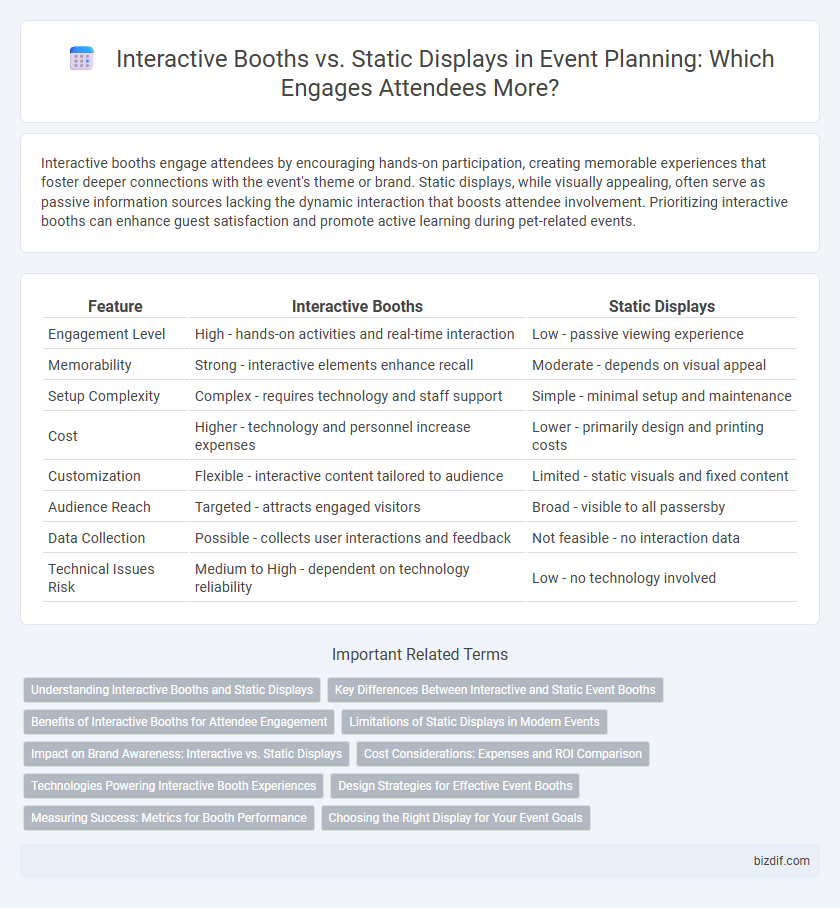Interactive booths engage attendees by encouraging hands-on participation, creating memorable experiences that foster deeper connections with the event's theme or brand. Static displays, while visually appealing, often serve as passive information sources lacking the dynamic interaction that boosts attendee involvement. Prioritizing interactive booths can enhance guest satisfaction and promote active learning during pet-related events.
Table of Comparison
| Feature | Interactive Booths | Static Displays |
|---|---|---|
| Engagement Level | High - hands-on activities and real-time interaction | Low - passive viewing experience |
| Memorability | Strong - interactive elements enhance recall | Moderate - depends on visual appeal |
| Setup Complexity | Complex - requires technology and staff support | Simple - minimal setup and maintenance |
| Cost | Higher - technology and personnel increase expenses | Lower - primarily design and printing costs |
| Customization | Flexible - interactive content tailored to audience | Limited - static visuals and fixed content |
| Audience Reach | Targeted - attracts engaged visitors | Broad - visible to all passersby |
| Data Collection | Possible - collects user interactions and feedback | Not feasible - no interaction data |
| Technical Issues Risk | Medium to High - dependent on technology reliability | Low - no technology involved |
Understanding Interactive Booths and Static Displays
Interactive booths engage attendees through hands-on activities, digital interfaces, and real-time demonstrations, making the experience immersive and memorable. Static displays rely on visuals such as posters, banners, and product samples to convey information without direct interaction. Understanding these formats helps event planners tailor engagement strategies to maximize audience participation and brand recall.
Key Differences Between Interactive and Static Event Booths
Interactive event booths engage attendees through dynamic features like touchscreens, games, or live demonstrations, fostering active participation and memorable experiences. Static displays rely on fixed visuals such as banners, posters, and product exhibits, providing information passively without direct visitor interaction. The key difference lies in attendee involvement: interactive booths drive engagement and data collection, while static displays focus on visual branding and passive communication.
Benefits of Interactive Booths for Attendee Engagement
Interactive booths significantly enhance attendee engagement by encouraging active participation, which leads to increased retention of information and a memorable event experience. Hands-on activities and real-time feedback create personalized interactions, fostering stronger connections between attendees and brands. Compared to static displays, interactive booths drive higher foot traffic and facilitate meaningful conversations, boosting overall event impact and ROI.
Limitations of Static Displays in Modern Events
Static displays in modern events often suffer from limited engagement and fail to capture attendees' attention compared to interactive booths. These displays lack real-time interaction, reducing opportunities for personalized experiences and meaningful attendee participation. The absence of dynamic content can lead to diminished brand recall and lower overall event impact.
Impact on Brand Awareness: Interactive vs. Static Displays
Interactive booths significantly boost brand awareness by engaging attendees through hands-on experiences, personalized interactions, and real-time feedback, creating memorable connections. Static displays rely primarily on visual appeal and informational content, which may limit audience engagement but still provide consistent brand exposure. Events featuring interactive elements often see higher retention rates and increased social media sharing, amplifying brand visibility beyond the event.
Cost Considerations: Expenses and ROI Comparison
Interactive booths typically require higher initial investment due to technology integration, staffing, and maintenance, but they generate greater engagement and measurable ROI through lead capture and data analytics. Static displays incur lower upfront costs with minimal upkeep, offering limited interaction and less quantifiable returns on marketing spend. Evaluating event goals and budget constraints helps determine if the increased expense of interactive booths aligns with desired conversion rates and overall event impact.
Technologies Powering Interactive Booth Experiences
Emerging technologies such as augmented reality (AR), virtual reality (VR), and touch-screen interfaces are revolutionizing interactive booth experiences by engaging attendees more effectively than static displays. These interactive technologies enable personalized content delivery, real-time data collection, and immersive brand storytelling that captivate event participants. Leveraging IoT sensors and AI-driven analytics further enhances user interaction, providing actionable insights and elevating overall event engagement.
Design Strategies for Effective Event Booths
Interactive booths enhance attendee engagement through dynamic elements such as touchscreens, virtual reality, and live demonstrations, fostering memorable brand experiences. Static displays rely on high-quality visuals, clear messaging, and strategic product placement to communicate value efficiently and attract passersby. Combining ergonomic layout with interactive technology and compelling graphics maximizes visitor interaction and boosts lead generation at trade shows and exhibitions.
Measuring Success: Metrics for Booth Performance
Interactive booths generate higher attendee engagement rates, often increasing dwell time by up to 70% compared to static displays. Key metrics for measuring booth performance include lead capture rates, interaction frequency, and qualitative feedback from participants. Event planners prioritize these data points to optimize ROI and tailor future event strategies effectively.
Choosing the Right Display for Your Event Goals
Interactive booths foster deeper attendee engagement through hands-on experiences, driving higher brand recall and lead generation compared to static displays. Static displays excel in delivering clear, concise messaging with lower maintenance, suitable for events prioritizing information dissemination over interaction. Aligning the choice with event goals--whether maximizing visitor interaction or efficiently communicating key messages--ensures optimal impact and ROI.
Interactive booths vs static displays Infographic

 bizdif.com
bizdif.com